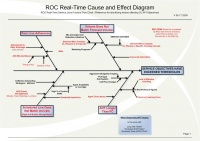Difference between revisions of "Main Page"
(→ROC Deployment) |
|||
| Line 1: | Line 1: | ||
| − | =Ted's | + | =Ted's "ROC" Projects= |
[[file:Roc1.jpg|thumb|400px|border|Southern Division ROC, September 2009]] | [[file:Roc1.jpg|thumb|400px|border|Southern Division ROC, September 2009]] | ||
==Resource Optimization Center (ROC) Build-Out== | ==Resource Optimization Center (ROC) Build-Out== | ||
Revision as of 09:23, 13 April 2014
Contents
Ted's "ROC" Projects
Resource Optimization Center (ROC) Build-Out
What Is The "ROC"?
The "ROC", or Resource Optimization Center is a business unit tasked to support the creation and adoption of “best practices” needed to maximize Customer Care resources. The ROC’s mission statement is to:
Drive efficiency and maximize Customer Care resources in the Southern Division through improved forecasting, call routing, workforce utilization, 3rd party allocation and oversight, and dynamic resource management.
The ROC will consolidate key WFM functions at Division:
- Forecasting Aggregation & Validation
- Call Routing Oversight, Avaya Skill Template Management
- Real-Time Monitoring and Incident Management
- Third Party Management, Forecasting & Real-Time Monitoring
- Bi-directional Interface with other functional departments
- Universal IVR Monitoring and Customer Experience Management
- Adoption of the WFM Best Practice Playbook
ROC Mission Statement
The ROC's mission is not to simply re-allocate call traffic, but to drive efficiencies in all areas of resource management, through both strategic planning (forecasting) and improved tactical execution (real-time management). The ROC's core goal is tied to a structured Event Management system. Through this Event Management system, the ROC creates cases to document periods of time throughout a day in which a call center fails to operate within Service Level targets. The method of capturing these events is tied to a fixed cause-effect fishbone, allowing for consistent conclusions to be reached by the ROC Analyst working an event.
This analysis is central to the ROC's core goals. In providing daily case analysis, the ROC will capture patterns where failure in some area of resource management has led to a degradation in service level. The cases provide support to determine where investments need to be made to improve methods used in strategic planning and real-time resource management in a call center.
In summary, successful execution of the ROC's goals requires consistency across the call routing technology deployed, and in the software application utilized for workforce management (forecasting, scheduling and real-time management). Without a common ACD and WFM platform, with standard definitions, the ROC would be severely limited in its capability to do comparative analysis.
ROC Deployment
I launched my first ROC Project at Comcast on June 22nd, 2009, with the goal to deploy the operation in 90 days. Standard project management discipline was used for planning, organizing, and managing resources associated with the ROC project. This project is managed through Quickbase. The ROC Project was categorized into 5 groups, with 85 tasks. After 90 days, 56 of the 95 tasks are 100% complete, with the remaining "in-progress" tasks in the areas of:
- Completion of hiring of analysts
- Building of SOPs for both Real-Time and Strategic operations, and
- Application & Software development.
The ROC Project finished on target for deployment, and under budget, with the completion of most major launch tasks on or before September 22nd. September 22nd marks the Soft Launch of the ROC Control Room, with equipment installed, and hired resources deployed. The following phase focused on the application configuration and SOP establishment, which continues to be fine-tuned throughout Q4, 2009 - Q1, 2010. The next major milestone completed was a full Operational Launch; after sufficient application tuning and SOP development is developed to provide beneficial input into overall resource management, the ROC will Operationally Launch. This milestone was reached October 22nd. The final 60 days of 2009 will be utilized to expand SOPs, fine tune applications, and begin to establish recommendations for optimizing resources and routing.


